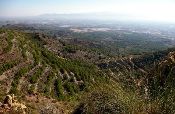| Drivers, policies and laws |
 |
|
Note: the drivers, policies and laws are the same for both the Mação and Góis study sites
The reasons for desertification and land degradation occurring can be environmental (for example due to the climate or soil conditions), economic, due to the actions of people or, most often, due to a combination of factors. The resulting degradation may be temporary or permanent.
To help understand this complex picture it can be helpful to think in terms the dominant socio-economic and environmental forces that are driving the process of land degradation. These place pressures on the land which have particular impacts. Human society may have already made responses to those impacts, or may have knowledge about how they could respond. Decisions about which responses to make may also be governed by a range of international, national or local policy regulations and agreements.
In the Mação study site, the same stakeholder workshop and questionnaires that were used to identify existing and potential response strategies (»Identifying strategies: Stakeholder workshop 1) also discussed and identified these driving forces; pressures; impacts; and the policy and regulation environment. This information was then used to inform the choice of »Field experiments, the scenarios used in »Simulated biophysical impact of remediation strategies and their financial viability, and context for the study site-specific »Policy brief recommendations.
|
||||||||
Study sites

Acknowledgement
The DESIRE project was
|
DESIRE brought together the expertise of
26 international research institutes
and non-governmental organisations.
This website does not necessarily
represent the opinion of the
European Commission. The European
Commission is not responsible for
any use that might be made of the
information contained herein. 
